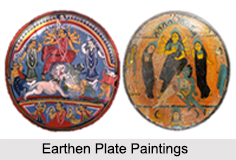 Before the Partition of India, the earthen plate paintings were produced extensively in Dhaka, Barishal and Faridpur districts of East Bengal, currently Bangladesh. But after the partition, some of the artisans moved and settled in Nadia and parts of 24 Parganas in the state of West Bengal. These earthen plate paintings are also available in Kolkata and its adjoining areas.
Before the Partition of India, the earthen plate paintings were produced extensively in Dhaka, Barishal and Faridpur districts of East Bengal, currently Bangladesh. But after the partition, some of the artisans moved and settled in Nadia and parts of 24 Parganas in the state of West Bengal. These earthen plate paintings are also available in Kolkata and its adjoining areas.
These earthen plate paintings are mainly made for Goddess Lakshmi to celebrate Lakshmi Puja on the full moon night sometime between the Bengali month of Ashwin and Kartik.
Description of Earthen Plate Paintings
Made on shallow earthen plates, these earthen plate paintings vary in size ranging from small to large with a diameter varying from 25 to 75 cm. With a slightly convex back, the earthen plate paintings are not exactly of semi spherical in shape and have 2 holes on the upper part of the plate on opposite ends so that it can be hung by a string.
In earlier days, the potters or acharyas belonging to the Brahmin community were the only ones who used to solely undertake the craft of painting earthen plates. This archaic system is no longer in practise, as potters, carpenters and painters of diverse background partake in the painting of earthen plates in West Bengal.
The shallow plates drawn by the Brahmin acharyas were often called "Acharjee Plates" after the names of the painters. In colloquial terms, if the principal image of the Goddess is accompanied by 2 or 4 companions, the paintings are denoted as shallow plates of 3 dolls or 5 dolls, respectively. At one time, Sureshwar village in the Faridpur District of erstwhile East Bengal was renowned for production of painted shallow plates, which were named as Sureshwari plates. The top part of these shallow plates showed Goddess Durga in her typical pose of slaying Mahishasura with her children- Goddess Saraswati, Lord Kartikeya, Goddess Lakshmi and Lord Ganesha, standing beside her, while the lower part contained the image of Goddess Lakshmi and her owl.
Technique of Earthen Plate Paintings
With a scraped convex surface, the earthen plate is made smooth with a layer of chalk on the surface. The artist draws bold lines in black and sketches out few sections on the surface and after the painting is finally dry, the final image is revealed to be Goddess Lakshmi, her owl, cornstalks, miniature conches, etc. The borders are first drawn in red or black and then the intervening spaces are filled up with red, yellow, blue and green colours. Thus, the entire painting displays a marked similarity with the creative style adopted for the background paintings of deities. After the painting is completed, a paste of sago or tamarind seed is applied on the surface first, and then, it is finished with resin dissolved in turpentine oil to obtain an enhanced brightness and transparency.
These earthen plate paintings lack the exaggerated ornamental designs as these paintings are done quickly with fine brush strokes. The earthen plates are painted in a traditional way that highlights the simplicity and liveliness of the paintings which pay tribute to Goddess Lakshmi, who symbolises a glorious example of the folk art of Bengal.



















